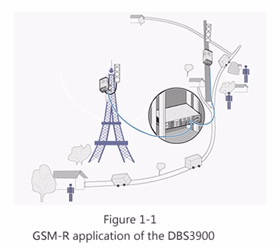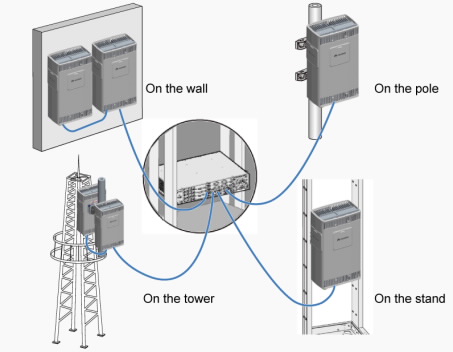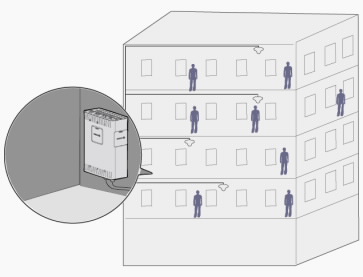DBS3900
Customer-oriented and innovative, Huawei spares no effort in developing distributed base stations and pioneers cutting-edge base station technologies. The industry-leading distributed base station — the Huawei DBS3900 GSM-R (hereafter referred to as DBS3900) — aims at constructing future-oriented networks for operators. It comes with only two basic functional modules: the baseband control unit BBU3900 and the remote radio unit (RRU) thta are connected through CPRI ports. Featuring a compact structure, high integration, low power consumption, the DBS3900 allows for easy installation and fast deployment.
Simple Structure and Fast Network Deployment
The DBS3900 has only two types of basic functional modules, thus greatly reducing the investment in spare parts and maintenance. With excellent environment adaptability, basic modules can be easily adapted to onsite conditions to achieve efficient deployment, obviating an equipment room. That is, there is no additional cost of construction an equipment room.
Flexible Installation and Particularly Well-Suited to Railway Coverage
The remote radio module provides the following benefits:
- Since the RF module of the DBS3900 can be mounted on top of the tower, the feeder length is significantly reduced and the cost of procuring feeders is decreased accordingly.
- Moreover, the decrease in feeder loss results in a power gain increase of 3 dB to 5 dB and improvement in the coverage radius by over 20%. Thus, the coverage capability of the traditional macro BTS can be achieved at a lower Top-of-Cabinet transmit power (TOC).
- Thanks to the radio remote technology, the DBS3900 supports distributed installation of baseband and RF modules, which provides great flexibility to design the coverage along railway lines.
Cell Expansion with Multi-RRU, Multi-Site Cell Feature
Thanks to the distributed design, all the RRUs controlled by one BBU can be configured with the same frequency and installed at different locations along railways. The whole DBS, such as the BBU and all the RRUs connected to it, belongs to one single cell. The most significant advantage of such a scheme is to reduce the amount of inter-cell handovers. Compared with the repeater, each RRU can produce and manage the radio signal independently, noise is not amplified by the succession of passive lossy devices, and the DBS can be managed in its entirety (BBU and all its RRUs) by a unified maintenance interface.
Protection Against BBU Failure: Single Frequency Double Coverage Feature
The single frequency double coverage scheme enables two BTSs working in active/standby mode to cover the same area. In addition, only one of the BTSs is working at any specific time. The two BTSs use exactly the same frequencies. In normal cases, the active BTS works properly, whereas the standby BTS works but does not transmit power. When the active BTS is faulty, the BSC triggers the switchover between the active BTS and the standby BTS. Specifically, the previously active BTS is downgraded to "standby BTS" status, whereas the previously standby BTS is upgraded to "active BTS" status. This redundant coverage does not require any additional frequencies compared to single coverage, thus improving network availability and ensuring continued network operation even in the case of a BTS failure.
Protection Against BBU Failure: BBU Redundancy Feature
The RRUs are connected to both the active and the standby BBU. That is, each RRU is connected to two BBUs. Under normal circumstances, the RRU communicates with only the active BBU. Under normal circumstances, the RRU communicates with only the active BBU. With the BBU Redundancy feature, the RRU supports automatic switchover of CPRI ports in case of BBU failure. When a failure occurs on the active BBU, the BSC switches over the active and standby BBUs so that the standby BBU becomes active. The RRUs, in turn, trigger the CPRI port switchover. After the CPRI port switchover, the RRUs communicate with the newly active BBU.
Low Power Consumption and Energy Efficiency Savings
Thanks to advanced hardware designs, for example, multi-carrier PA, as well as a whole set of software power saving features such as intelligent PA management, the power consumption of the DBS3900 is greatly reduced, which makes it possible for the BTS to be powered by green energy such as the solar power, wind power, and biogas. Meanwhile its natural heat dissipation design enables the RF module to operate without fans, which helps further reduce power consumption without generating noise or fan-related faults. All these features are conducive to the construction of environmentally-friendly networks for operators.
Technical specifications of the DBS3900 GSM
| Item | Specification | ||||||||
|---|---|---|---|---|---|---|---|---|---|
| Supported frequency band | Frequency band | RX band (MHz) | TX band (MHz) | ||||||
| RRU3004 | RGSM 900M | 876-915 | 921-960 | ||||||
| EGSM 900M | 880-915 | 925-960 | |||||||
| GSM 1800M | 1710-1785 | 1805-1880 | |||||||
| Capacity | RRU3004 | Up to 24 carriers per cell; up to 36 carriers per site Maximum configuration: S12/12/12 | |||||||
| Receiver static sensitivity | RRU3004 | RX independency | 2-way RX diversity | ||||||
| –113 dBm | –116 dBm | ||||||||
| Output power (TOC, Top-of- Cabinet) | RRU3004 | 900 MHz (GMSK/8PSK) With no internal combination: 30 W/20 W With internal combination: 15 W/10 W With PBT: 40 W/25 W |
1800 MHz (GMSK/8PSK) With no internal combination: 20 W/15 W With internal combination: 10 W/7.5 W With PBT: 30 W/20 W | ||||||
| Power consumption | Configuration | Typical value (W) | |||||||
| 1BBU3900+1RRU3004 | 200 | ||||||||
| 1BBU3900+2RRU3004 | 320 | ||||||||
| 1BBU3900+6RRU3004 | 800 | ||||||||
| Transmission port | 4 E1s/T1s | ||||||||
| Dimensions | Item | Height (mm) | Width (mm) | Depth (mm) | |||||
| BBU3900 | 86 | 442 | 310 | ||||||
| RRU3004 | 480 | 356 | 100 | ||||||
| RRU3004 (with housing) | 485 | 380 | 130 | ||||||
| Weight | BBU3900 | 7 kg (typical); 12 kg (maximum) | |||||||
| RRU3004 | 15 kg (without housing); 17 kg (with housing) | ||||||||
| Input power | BBU3900 | –48 V DC, voltage range: –38.4 V DC to –57 V DC +24 V DC, voltage range: +21.6 V DC to +29 V DC | |||||||
| RRU | –48 V DC, voltage range: –36 V DC to –57 V DC 220 V AC, voltage range: 176 V AC to 290 V AC | ||||||||
| Temperature | BBU3900: –20°C to +55°C RRU (without solar radiation): –40°C to +50°C RRU (with solar radiation): –40°C to +45°C | ||||||||
| Relative humidity | BBU3900: 5% RH to 95% RH | ||||||||
| RRU: 5% RH to 100% RH | |||||||||
| Air pressure | 70 kPa to 106 kPa | ||||||||
| Protection degree | BBU3900: IP20 RRU: IP65 | ||||||||
| Anti-seismic performance | BBU3900: IEC 60068-2-57 (1999-11) RRU: NEBS GR63 zone4 | ||||||||
| RET antenna | In compliance with the AISG2.0 protocol | ||||||||
| Storage environment | ETSI EN 300019-1-1 V2.1.4 (2003-04) Class 1.2: "Weather protected, not temperature-controlled storage locations" | ||||||||
| Transportation environment | ETSI EN 300019-1-2 V2.1.4 (2003-04) Class 2.3: "Public transportation" | ||||||||
| Operating environment | BBU3900 in compliance with: ETSI EN 300019-1-3 V2.2.2 (2004-07) Class 3.1: "Temperature-controlled locations" | ||||||||
| RRU in compliance with: 3G TS25.141 V3.0.0 ETSI EN 300019-1-4 V2.1.2 (2003-04) Class 4.1: "Non-weather protected locations" | |||||||||
| RF specification | 3GPP TS 45.005 V8.2.0 multicarrier BTS class 2 requirement | ||||||||
| EMC | The DBS3900 meets the EMC requirements and complies with the following standards: R&TTE Directive 99/5/EC 3GPP TS 25.113 V4.4.0 (2002-12) ETSI EN 301 489-1 V1.5.1 (2004-11) ETSI EN 301 908-1 V2.2.1 (2003-10) ITU-T SM 329-10(2003) FCC PART15 CENELEC EN 50121-4 | ||||||||
Figure 1-1 shows the GSM-R application of the DBS3900.
With a compact case structure, the BBU3900 occupies a 19-inch-wide and 2-U-high space. It can be installed on a wall, on stairs, or in a storeroom. It can also be installed in the cabinet of the existing network equipment. Figure 2-1 shows the appearance of the BBU3900.


Typical Installation Scenarios of the DBS3900
As demand for environmental protection and lease cost has increased, constructing new sites has become increasingly difficult. The DBS3900 developed by Huawei features high integration, easy installation, and low environmental requirements. All these features facilitate site acquisition and co-siting with an existing site. The BBU3900 has a compact case structure that only requires a 19-inch-wide and 2-U-high space. It can be installed on the wall, on a stairs, or in a storeroom. It can also be installed in the outdoor cabinet of an existing network equipment. The RRUs can be mounted on a pole, tower, wall, or stand. The RRU supports up to three levels of cascading. One RRU module can be placed at most 40 km away from the BBU3900.
Figure 3-1 shows typical installation scenarios of the DBS3900.

Typical installation scenarios of the DBS3900
Applications of the DBS390
Possessing features such as flexible installation, natural heat dissipation, quiet operation, and quick network construction, the DBS3900 is applicable to scenarios such as indoor coverage and coverage along railways (including large-scale major stations and tunnel coverage).
Coverage Along Railways and Highways
With several RRUs sharing one cell, the DBS3900 helps reduce the number of inter-cell handovers. This improves QoS for users during high-speed movement, which provides an ideal solution to coverage along railways and highways and tunnels. Figure 3-2 shows the typical application scenario of coverage along railways and highways.

Coverage along railways and highways
Indoor Coverage in Station Buildings
As to the indoor coverage in buildings, the DBS3900 provides an effective solution with desirable features, typified by a small space and quick site deployment. Figure 3-3 shows the typical application scenario of the coverage in buildings.

Indoor coverage in Station buildings
Coverage Of Tunnels
The advantages of using DBS3900 for tunnel coverage are as follows:
- Reduce the number of handovers by using the Multi-Site Cell feature.
- Avoid the disturbance brought by repeater.
- Share the same NMS with other BTS.


















